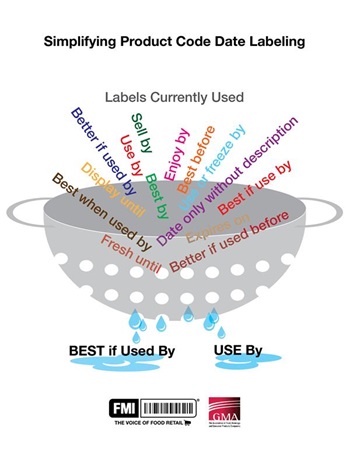
Playwright George Bernard Shaw is credited with the observation, “The single biggest problem in communication is the illusion that it has taken place.” In an economy of words, Shaw answered the human quandary of why - upon analysis - so very many difficulties and problems are summarily assessed with some version of the phrase, “there was a ’failure to communicate.’” Given how easily miscommunication occurs – or said another way, for communication to NOT occur – the lesson is simple for us. If communication matters, we must redouble our efforts to ensure it happens, even when we think we’ve been clear.
At the January 29 meeting of the Trading Partner Alliance (TPA), this joint group of members of the FMI and GMA executive committees affirmed a recommendation for industry-wide adoption of common product code date labeling language. This recommendation is the result of the year-long labor of a working group comprised of individuals from 25 FMI/GMA member companies, representing every food category and every aspect of food operations, including supply chain, sustainability, brand management/marketing, regulatory, government relations, food safety, consumer affairs, and quality control. The group was charged with finding suitable date label language to help reduce consumer confusion created by the divergent language currently in use, while being as sensitive as possible to consumer preferences, the impact on industry operations and potential pending legislation. Viewed more simply, this proposal demonstrates the industry’s redoubling of effort to communicate as clearly as possible with its customers via date labels.
This TPA affirmed recommendation calls for voluntary industry-wide adoption of two sets of product code date labeling language: one for shelf stable items, when the date is for communicating quality issues, and another for certain items when the date language conveys guidance regarding material degradation of product performance or the possibility of food safety concerns.
The focus of this proposal was to reach agreement on the product code date language to be used. However, reaching agreement on the words is not the end of the journey, there is much remaining work to be done regarding: 1) clarification of what falls into the two categories, particularly the latter; 2) determination of the industry posture toward federal legislation to address this issue; and 3) creation of a consumer education campaign to support and amplify the industry’s efforts at communicating clearly. The working group will continue to monitor ongoing work in these three work streams.
We cannot rest until we are confident we are “communicating,” and doing so clearly.
For more resources, visit FMI.org/ProductCodeDating.


 Industry Topics address your specific area of expertise with resources, reports, events and more.
Industry Topics address your specific area of expertise with resources, reports, events and more.
 Our Research covers consumer behavior and retail operation benchmarks so you can make informed business decisions.
Our Research covers consumer behavior and retail operation benchmarks so you can make informed business decisions.
 Events and Education including online and in-person help you advance your food retail career.
Events and Education including online and in-person help you advance your food retail career.
 Food Safety training, resources and guidance that help you create a company food safety culture.
Food Safety training, resources and guidance that help you create a company food safety culture.
 Government Affairs work — federal and state — on the latest food industry policy, regulatory and legislative issues.
Government Affairs work — federal and state — on the latest food industry policy, regulatory and legislative issues.
 Get Involved. From industry awards to newsletters and committees, these resources help you take advantage of your membership.
Get Involved. From industry awards to newsletters and committees, these resources help you take advantage of your membership.
 Best practices, guidance documents, infographics, signage and more for the food industry on the COVID-19 pandemic.
Best practices, guidance documents, infographics, signage and more for the food industry on the COVID-19 pandemic.
